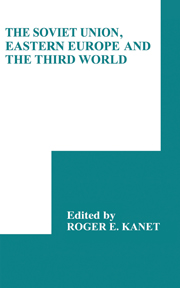Book contents
- Frontmatter
- Contents
- List of figures
- List of tables
- List of contributors
- Foreword by R.C. Elwood
- Preface by Roger E. Kanet
- PART 1 THE THIRD WORLD IN SOVIET FOREIGN POLICY
- PART 2 CMEA ECONOMIC INVOLVEMENT IN THE THIRD WORLD
- 6 Soviet economic policy in the Third World
- 7 Eastern Europe and the Third World: Economic interactions and policies
- 8 The non-European members of the CMEA: a model for developing countries?
- PART 3 THE SOVIET UNION IN THE MIDDLE EAST AND SOUTH ASIA
- Index
- Publications from the Third World Congress for Soviet and East European Studies, Washington, 1985
8 - The non-European members of the CMEA: a model for developing countries?
from PART 2 - CMEA ECONOMIC INVOLVEMENT IN THE THIRD WORLD
Published online by Cambridge University Press: 06 July 2010
- Frontmatter
- Contents
- List of figures
- List of tables
- List of contributors
- Foreword by R.C. Elwood
- Preface by Roger E. Kanet
- PART 1 THE THIRD WORLD IN SOVIET FOREIGN POLICY
- PART 2 CMEA ECONOMIC INVOLVEMENT IN THE THIRD WORLD
- 6 Soviet economic policy in the Third World
- 7 Eastern Europe and the Third World: Economic interactions and policies
- 8 The non-European members of the CMEA: a model for developing countries?
- PART 3 THE SOVIET UNION IN THE MIDDLE EAST AND SOUTH ASIA
- Index
- Publications from the Third World Congress for Soviet and East European Studies, Washington, 1985
Summary
The Council for Mutual Economic Assistance (CMEA) is a mixed organization. Apart from the USSR and Eastern Europe it includes three developing countries: Mongolia, Cuba and Vietnam. Mongolia was admitted in 1962 with few problems, probably because of its low population. Cuba entered in 1972 after a long delay, and Vietnam joined in 1978 in spite of opposition by at least one industrialized member, Czechoslovakia. Among those developing countries with the status of observers, Laos failed to gain admission once and Mozambique has been rejected twice.
This chapter will concentrate on only one very important aspect of foreign economic relations of the three developing members of CMEA, namely the foreign trade sector. The foreign trade of developing countries is generally characterized by an extreme dependence on one or a few partners and/or commodities; by a predominance of raw materials and intermediate goods in their exports, and of machinery and equipment, together with fuels and foodstuffs, in their imports; by a high degree of vulnerability to price fluctuations in the world market; and, lastly, by huge trade deficits. With these facts in mind, it is useful to try to determine whether joining the CMEA has meant the end of dependency relations for the three countries in question or rather the transformation of their old bonds into new, more sophisticated ones.
- Type
- Chapter
- Information
- The Soviet Union, Eastern Europe and the Third World , pp. 163 - 180Publisher: Cambridge University PressPrint publication year: 1988



